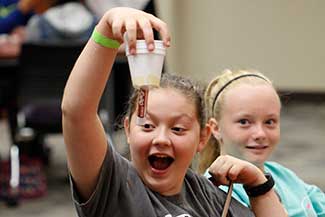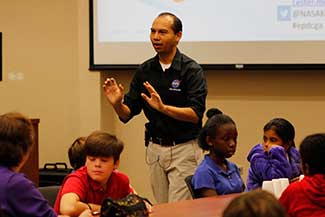UWG, NASA Wow Next Generation of Explorers
by Julie Lineback
Just a couple of generations ago, the concept of humans traveling to Mars was the stuff science fiction movies were made of. Today, according to NASA Kennedy Space Center’s Dr. Lester Morales and Rachel Power, that journey is on the horizon.
The reality of such a possibility was brought to the attention of hundreds of sixth and eighth graders as they descended upon the University of West Georgia on September 14 as the College of Education (COE) and the National Aeronautics and Space Administration (NASA) hosted interactive sessions intent on piquing the interests of young minds in the science, technology, engineering, and mathematics (STEM) fields. An overview of the event can be viewed at https://youtu.be/8ruVPElalV4.
“The first person to walk on Mars will be in the 2030s,” Rachel, a digital network specialist, told the wide-eyed audience. “You guys will be about 32, and that’s the perfect age to be an astronaut. What if it’s your name [everyone recognizes because you were] the first person to walk on another planet?”
But before humankind makes that next giant leap, the pre-teens in attendance listened in awe as they learned how NASA is working with robots to make that happen. Currently, the robotic rover “Curiosity” is busy traversing the red planet and sending back very detailed information on the composition, climate, and geology of Mars. Robonaut 2 (R2) is NASA’s first humanoid robot in space. Video and images flashed onscreen during Dr. Morales’ presentation of R2 shaking hands, writing, picking up objects, holding tools, and lifting heavy items. Because R2 has most recently been stationary inside the International Space Station (ISS), it doesn’t have a need for legs, something that NASA is currently remedying in order to further its exploration.
Dr. Morales, an education professional development specialist, led the students in a hands-on activity that mimicked an end effector of a robotic arm similar to the one on R2 using two Styrofoam cups and three strings. By using these few materials, the students were able to lift a bottle of water.
 “Imagine this is a 50lb bag I am lifting from the ISS,” he said as he lifted the bottle then looped the strings around. “If the bottle of water was my cargo, I should be able to put my arm around my cargo. I should be able to pull with my left hand and twist with my right hand. You will feel it lock, and once it locks you can lift your cargo.”
“Imagine this is a 50lb bag I am lifting from the ISS,” he said as he lifted the bottle then looped the strings around. “If the bottle of water was my cargo, I should be able to put my arm around my cargo. I should be able to pull with my left hand and twist with my right hand. You will feel it lock, and once it locks you can lift your cargo.”
Bremen Middle School sixth grader Elle Waldrep said she enjoyed this demonstration the best. “My favorite part was making the cup and taping the string onto it because it could pick up heavy objects like the water bottle,” she said.
In addition to the live activity with Dr. Morales, students were also able to chat virtually with Rachel regarding our solar neighborhood: the planets, dwarf planets, asteroids, comets, moons, and our one star—the sun.
“At night when you look at the sky and see stars, those are other neighborhoods,” Rachel explained. “Think about that—each star has planets revolving around it. Right now there are 1,952 confirmed exoplanets, which are planets found orbiting other stars. When you think about it, every star has at least one planet. Imagine if we were talking about counting stars, instead we tried to count planets.”
Rachel’s tour of our celestial vicinity was followed up by a spirited round of questions and answers that ranged from the composition of the sun, solar flares, the color of our galaxy, and the difference between wormholes and black holes.
“A few things that I learned today were how the sun was formed and the life cycle of stars,” said Andrew Luckey, a sixth grader at Bremen Middle School. “A few things that I thought were real interesting were all the different technology and robotics that NASA uses for all their space explorations so they don’t risk the astronauts’ lives.”

Dr. Lester Morales leads students in a hands-on activity.
As one of the state’s leading universities in preparing teachers for STEM education, COE takes this charge very seriously.
“It’s really important for Georgia’s future to have students who major in STEM disciplines, but to do that we know that students have to get interested in these fields early,” COE Dean Dr. Dianne Hoff said. “If we don’t have great teachers in science and mathematics, then students later never become STEM majors.”
NASA and UWG have been in a partnership for five years, and Dr. Morales considers campus as a central location where NASA can host big events and invite scientists, engineers, educators, students, and the community to come together and learn about its missions.
“The University of West Georgia is a great partner to have because they are able to expose students to the kind of exploration that NASA’s doing,” Dr. Morales said. “The students get to see some real applications of what they’re learning in the classroom and where they can see the connection between real world application and classroom learning and space exploration. What better place to show that than a university campus?”
Do you have a comment or opinion about this story's topic? Perspective Online wants to hear from you. Submit a letter to the editor today.
